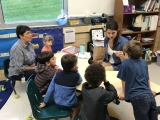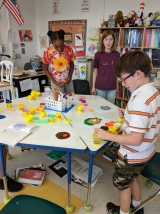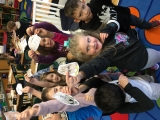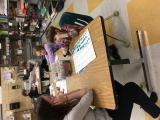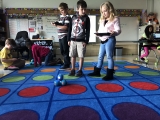-
Category 1
Selected in 2018
-
Grades: k - 5
School Setting: urban
Town Population: 24,000
Student Enrollment: 434
Student Demographics:
Black/African American: 11%
Teacher/Student Ratio: 1:11
White/Caucasian: 70%
Hispanic: 4%
Hawaiian/Pacific Islander: 0%
Asian: 1%
Native American: 0%
Other: 14%
% Reduced Lunch: 51%
% ELL Learners: 1%
Founded: 1956 -
PRINCIPAL:
Sharon Barker -
CONTACT:
330 Grubert Avenue
Staunton, VA 24401
540-332-3938
sbarker@staunton.k12.va.us
A.R. Ware Elementary School
Staunton, VA
The greatest contributing factor for the success at Ware Elementary is aligned with research that impacts student learning.
- Describe specific programs in place to ensure that families are involved in the success of your school and students.
-
Teachers at Ware Elementary School are intentional about making positive connections with both parents and students. The school has a parent advisory council who meets to reflect on parent and school needs, develop a parent involvement plan and compact, and create a timeline and implement parent involvement events and activities throughout the year.
The school offers a variety of programs that are intended to support academic needs. For example, the Kindergarten teachers have recently planned a "Concept of Word" night for parents. The school "Lunch and Learns", which are designed to offer reading, mathematics, or other training during different times of the day. An example of an event last year was GingerLand (a life-size version of CandyLand), where students and families moved through the gym to grade-level designed constructions, where they could zap the QR code to learn more (such as the 1st grade video of their lego engineered constructions and writing). - Describe the most successful activity your school has initiated to strengthen ties to your community.
- There isn't one isolated activity that has helped to strengthen ties to our community, rather, several things link together to make families and community members feel connected. The school has a Facebook page that allows parents and community members to have immediate information. Our counselor conducts presentations based on parental surveys at various times to accommodate various work schedules. Teachers are charged with making phone or face to face contact with each child's caregiver within the first month of school. Our school has participated in equity training, created a community connections committee, and maintains a strong focus on creating positive students/family relationships. The PTA utilizes their Facebook page and Tuesday folders to communicate with parents. Our division celebrates community support yearly with an awards ceremony. On my desk is a copy of the book School's Can't Do It Alone. At Ware we know this to be true and value the community support we receive.
- Describe your philosophy of school change or improvement.
- Focusing on solid research based instructional practices and building individual teacher efficacy and collective capacity have been our guiding lights in this process of school improvement.
- What are your school’s top two goals for the next year?
-
1. Reflecting on and refining our understanding and implementation of collective teacher efficacy, teacher clarity, feedback, learning goals, learning intentions, and success criteria.
2. Focusing on the physical, emotional, and educational needs of our students, our school hopes serve as a support and resource for parents and community members. - What is the single most important factor in the success of your school that others could replicate?
-
The greatest contributing factor for the success at Ware Elementary is aligned with research that impacts student learning - an ongoing focus on learning goals. The strategies listed have an effect size greater than 0.4 based on meta-analysis research (Hattie, 2018), which means that they produce more than a year's growth in a year.
· Collective teacher efficacy = 1.57
· Teacher clarity = 0.75
· Feedback = 0.70
· Learning goals = 0.68
· Learning intentions = 0.48
When teachers know where they need to be, they are able to articulate that to their students, which leads to increased student ownership. When everyone focuses on specific learning outcomes, there is a sense of collective teacher efficacy, as each person on the Ware team feels confident in the work of others in impacting student learning. - Describe the program or initiative that has had the greatest positive effect on student achievement, including closing achievement or opportunity gaps, if applicable.
- Ongoing professional support and development occurs through an instructional coaching model, where the reading coach and math coach provide feedback and in-class coaching. Research has demonstrated that this method (as opposed to solely providing professional development) makes it more likely that teachers will take ownership of new strategies and teaching techniques, causing a significantly higher rate of transfer into classroom practice.
- Explain how ESEA federal funds are used to support your improvement efforts.
- The majority of ESEA federal funds are used to support the instructional coaching model. We also use funds to support supplemental materials, such as literacy libraries and mathematics manipulatives. Funds are also used to support our parent outreach events.
- Identify the critical professional development activities you use to improve teaching and student learning.
- Each year, the school updates its professional learning plan. However, there are several themes that have been focus areas in the school's and division's plan, including: the work of Professional Learning Communities (PLC), using data, and engaging students for deeper understanding. In particular, the school has been focused on high-yield instructional strategies (John Hattie) for several years. The progression has included a focus on learning intentions, success criteria, feedback, and assessment-capable learners. Both school and division administrators visit in classrooms often in order to provide feedback to teachers related to these focus areas. For example, during the 2017-2018 school year, 357 observations and walk-throughs were completed with follow-up feedback about “what went well” and ideas for making instructional impact “even better”.
- Describe how data is used to improve student achievement and inform decision making.
-
There is a clear focus on the "impact" that our instruction is having on learning, as the leadership team, grade-level professional learning communities, teachers, and students regularly examine data. Examples include:
· The school maintains a data matrix (including both reading and mathematics data) during the year that is regularly discussed and used for decision-making. Teachers focus on both achievement and growth for students.
· Grade-level professional learning communities use formative assessments to monitor progress and adjust instruction accordingly.
· An emphasis has been placed on students assessing their own work. All teachers have been focused on learning intentions and making sure students understand these for each lesson. Once students know and understand these, they can be better involved in the assessment process. For example, some teachers use rubrics and worked examples to help students self-evaluate their work and become“assessment-capable learners”.
- Describe your school culture and explain changes you’ve taken to improve it.
- Making the school a welcoming place that students want to return to each and every day is an important part of student success. Common terms at A. R. Ware Elementary are "I can..." and “Not Yet...” These statements, which are tied to the learning outcomes, are intended as a way for students to help measure their academic success by what they are able to do or will be able to do with continued practice and focus, and teachers work to help students gain both the confidence and skillset to meet these challenges. The school has a "success block" built into the school day, where teachers work collaboratively within the grade level to re-group students to support particular areas in reading or mathematics that need support or extension. This across-grade grouping also supports increased communication, conversation, and problem-solving within the grade about strengths, needs, and strategies for success.
Stats
-
Category 1
Selected in 2018
-
Grades: k - 5
School Setting: urban
Town Population: 24,000
Student Enrollment: 434
Student Demographics:
Black/African American: 11%
Teacher/Student Ratio: 1:11
White/Caucasian: 70%
Hispanic: 4%
Hawaiian/Pacific Islander: 0%
Asian: 1%
Native American: 0%
Other: 14%
% Reduced Lunch: 51%
% ELL Learners: 1%
Founded: 1956 -
PRINCIPAL:
Sharon Barker -
CONTACT:
330 Grubert Avenue
Staunton, VA 24401
540-332-3938
sbarker@staunton.k12.va.us


